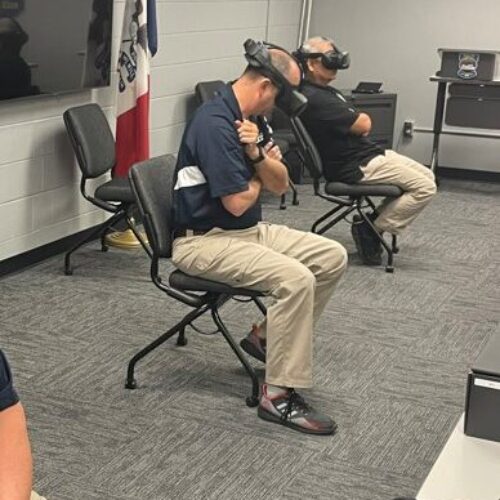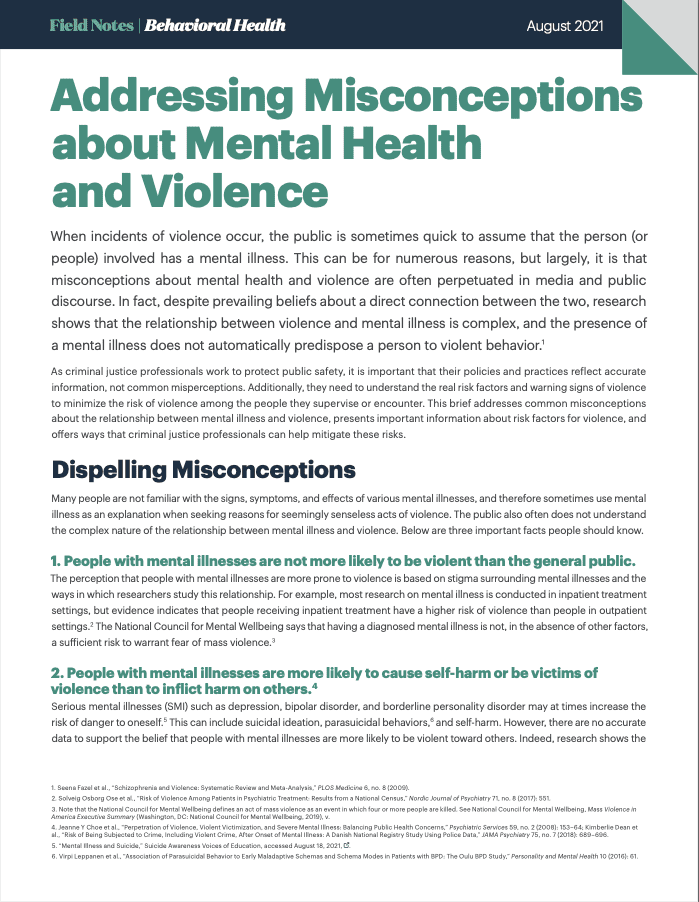Addressing Misconceptions about Mental Health and Violence
Despite public perception that there is a direct connection between mental health and violence, research shows that this relationship is complex and that the presence of a mental illness doesn’t automatically predispose a person to violent behavior. As criminal justice professionals work to protect public safety, it’s important that their policies and practices reflect accurate information, not common misperceptions. This brief addresses these misconceptions, presents important information about risk factors for violence, and offers ways that criminal justice professionals can help mitigate such risks.
Addressing Misconceptions about Mental Health and Violence
When incidents of violence occur, the public is sometimes quick to assume that the person (or people) involved has a mental illness. This can be for numerous reasons, but largely, it is that misconceptions about mental health and violence are often perpetuated in media and public discourse. In fact, despite prevailing beliefs about a direct connection between the two, research shows that the relationship between violence and mental illness is complex, and the presence of a mental illness does not automatically predispose a person to violent behavior.1
As criminal justice professionals work to protect public safety, it is important that their policies and practices reflect accurate information, not common misperceptions. Additionally, they need to understand the real risk factors and warning signs of violence to minimize the risk of violence among the people they supervise or encounter. This brief addresses common misconceptions about the relationship between mental illness and violence, presents important information about risk factors for violence, and offers ways that criminal justice professionals can help mitigate these risks.
Dispelling Misconceptions
Many people are not familiar with the signs, symptoms, and effects of various mental illnesses, and therefore sometimes use mental illness as an explanation when seeking reasons for seemingly senseless acts of violence. The public also often does not understand the complex nature of the relationship between mental illness and violence. Below are three important facts people should know.
1. People with mental illnesses are not more likely to be violent than the general public.
The perception that people with mental illnesses are more prone to violence is based on the stigma surrounding mental illnesses and the ways in which researchers study this relationship. For example, most research on mental illness is conducted in inpatient treatment settings, but evidence indicates that people receiving inpatient treatment have a higher risk of violence than people in outpatient settings.2
The National Council for Mental Wellbeing says that having a diagnosed mental illness is not, in the absence of other factors, a sufficient risk to warrant fear of mass violence.3
2. People with mental illnesses are more likely to cause self-harm or be victims of violence than to inflict harm on others.4
Serious mental illnesses (SMI) such as depression, bipolar disorder, and borderline personality disorder may at times increase the risk of danger to oneself.5
This can include suicidal ideation, parasuicidal behaviors,6 and self-harm. However, there are no accurate data to support the belief that people with mental illnesses are more likely to be violent toward others. Indeed, research shows the opposite—people with mental illnesses account for only about 4 percent of violent crime in the United States.7 When there is a direct relationship between people with SMI and violence, factors such as substance use8 and environmental stressors, such as poverty and housing instability are associated with the connection.9
3. Clinical assessments are not the most effective way to determine a person’s risk of violence.
Although clinical behavioral health practitioners have often been asked to determine the risk of violence a person with mental illness poses, research shows that clinicians’ judgment regarding risk is no better than chance.10 Instead, the use of actuarial violence risk assessment tools are more accurate, and tools have been developed to determine risk for specific types of violence including sexual violence11 and workplace violence.12 It is also important to keep in mind that clinicians and violence risk assessment tools, like most people and tools used in the criminal justice system, have inherent biases, even when there are good intentions. Criminal justice professionals should receive implicit bias training even when using violence risk assessment tools to mitigate some of these concerns.
Risk factors for violence
While people with mental illnesses are not predisposed to violent behavior, criminal justice professionals should still understand key risk factors for violence. These factors include:
Prior history of violent behavior
Previous acts of violence can be a risk factor for future violence, especially if other risk factors were and are present.13
Times of crisis
During times of crisis, anyone can be at an increased risk for acting out violently because they may have a lower tolerance for frustrations when stressed. For some people, this tolerance can drop so low that they are less able to control their behaviors. It is important to distinguish between a diagnosable mental illness and someone with mental health needs, however.14 For example, if someone is experiencing a time of stress, trauma, or crisis, such as being fired from a job, the breakdown of a relationship, or the loss of a loved one, it can be a risk factor for violence regardless of whether they have been diagnosed with a mental illness.15
Command auditory hallucinations
When someone is experiencing auditory hallucinations telling them to act in violence, this is considered a risk because they may follow the command.16 This may be especially true if the person has a history of acting on these types of commands. Increased stress may make this risk even more acute.
Substance use
Substance use can be a stand-alone risk factor or increase other risk factors for violence, especially co-occurring substance use and mental illness.17 Intoxication by some substances can increase the risk for violence, especially stimulants.18 Agitation, due to withdrawal or intoxication, is a sign someone should be assessed for risk of violence.
Mitigating Risks of Violence: Practical Steps
1. Understand the research.
Becoming familiar with the research and data on the relationship between mental illness and violence—as well as the general causes and risk factors for violent behavior—can help criminal justice professionals recognize warning signs and avoid misconceptions and biases. Understanding the research can also help agencies choose the most appropriate actuarial violence risk assessment tool, as well as help focus resources on people at highest risk for becoming violent based on the chosen assessment instrument.
2. Provide ongoing training.
Staff who may encounter people at risk of committing violence should be trained on recognizing risk factors and intervention methods, like de-escalation techniques. They should also receive implicit bias training and education on stereotypes so that they do not assume a person is dangerous simply because of a mental illness. This is especially important for Black, Indigenous, and People of Color (BIPOC) with mental illnesses, who can be seen as intimidating to some staff due to premature judgments, limited personal experiences, or prejudices.
3. Leverage community resources and their clinical expertise.
Criminal justice professionals should partner with local behavioral health treatment providers and access resources that can help them recognize people who are at risk to act violently. This can also help facilitate referrals when people are experiencing a mental health crisis. As partners, clinicians may be able to provide trainings to criminal justice staff on ways to identify signs and symptoms of risk. This partnership can also help make criminal justice staff aware of all the mental health resources that exist in their community, such as diversion programs, Assertive Community Treatment (ACT) Teams, or as a last resort, civil commitment.
Dig Deeper
The Council of State Governments Justice Center offers free in-depth subject matter expertise and can connect you to jurisdictions that are supporting people with serious mental illness to help them avoid violent behavior. Visit the Center for Justice and Mental Health Partnerships to learn more.
Additional Resources
Mass Violence in America: Causes, Impacts, and Solutions by National Council for Mental Wellbeing
Understanding and Managing Risks for People with Behavioral Health Needs by The Council of State Governments Justice Center
Footnotes
1 Seena Fazel et al., “Schizophrenia and Violence: Systematic Review and Meta-Analysis,” PLOS Medicine 6, no. 8 (2009).
2 Solveig Osborg Ose et al., “Risk of Violence Among Patients in Psychiatric Treatment: Results from a National Census,” Nordic Journal of Psychiatry 71, no. 8 (2017): 551.
3 Note that the National Council for Mental Wellbeing defines an act of mass violence as an event in which four or more people are killed. See National Council for Mental Wellbeing, Mass Violence in America Executive Summary (Washington, DC: National Council for Mental Wellbeing, 2019), v.
4 Jeanne Y Choe et al., “Perpetration of Violence, Violent Victimization, and Severe Mental Illness: Balancing Public Health Concerns,” Psychiatric Services 59, no. 2 (2008): 153–64; Kimberlie Dean et al., “Risk of Being Subjected to Crime, Including Violent Crime, After Onset of Mental Illness: A Danish National Registry Study Using Police Data,” JAMA Psychiatry 75, no. 7 (2018): 689–696.
5 “Mental Illness and Suicide,” Suicide Awareness Voices of Education, accessed August 18, 2021.
6 Virpi Leppanen et al., “Association of Parasuicidal Behavior to Early Maladaptive Schemas and Schema Modes in Patients with BPD: The Oulu BPD Study,” Personality and Mental Health 10 (2016): 61.
7 “This means that even if all of the association between mental illness and violence could somehow be eliminated, we would still have to confront 96 percent of the violence in the United States.” See John S. Rozel and Edward P. Mulvey, “The Link Between Mental Illness and Firearm Violence: Implications for Social Policy and Clinical Practice,” Annual Review of Clinical Psychology 13, (2017): 445–69.
8 Seena Fazel et al., “Schizophrenia and Violence: Systematic Review and Meta-Analysis,” PLOS Medicine 6, no. 8 (2009); Because substance use disorder is a criminogenic risk factor, which increases the likelihood someone will commit another crime, a high criminogenic risk level may increase the risk of violent crime. See also Fred Osher et al., Adults with Behavioral Health Needs Under Correctional Supervision: A Shared Framework for Reducing Recidivism and Promoting Recovery (New York: The Council of State Governments Justice Center, 2012).
9 Eric B. Elbogen and Sally C. Johnson, “The Intricate Link Between Violence and Mental Disorder: Results from the National Epidemiologic Survey on Alcohol and Related Conditions,” Arch Gen Psychiatry 66, no. 2 (2009): 152–161.
10 Claudia C. Hurducas et al., “Violence Risk Assessment Tools: A Systematic Review of Surveys,” International Journal of Forensic Mental Health 13, no. 3 (2014): 182; J. Monahan, The Clinical Prediction of Violent Behavior: An Assessment of Clinical Techniques (Lanham, MD: Jason Aronson, 1981).
11 Ibid
12 Dr. J. Reid Meloy, Dr. Stephen G. White, and Dr. Stephen Hart, “Workplace Assessment of Targeted Violence Risk: The Development and Reliability of the WAVR-21,” Journal of Forensic Sciences 58,
no. 5 (2013): 1353.
14 In times of transition or stress, many people may experience some mental health needs that don’t rise to the level of a diagnosable mental illness. They may benefit from behavioral health supports like talk therapy or skill-building exercises to strengthen coping skills. See American Psychiatric Association, Diagnostic and Statistical Manual of Mental Disorders: DSM-5 (Arlington, VA: American Psychiatric Association, 2013).
15 In one study of 28 acts of violence, every person who committed the act had recent stressors reported. See National Council for Mental Wellbeing, Mass Violence in America Executive Summary (Washington, DC: National Council for Mental Wellbeing, 2019), 11.
16 R. Upthegrove et al., “Understanding Auditory Verbal Hallucinations: A Systematic Review of Current Evidence,” Acta Pschiatrica Scandanavica 188 (2016): 355.
17 Elbogen and Johnson, “The Intricate Link Between Violence and Mental Disorder: Results from the National Epidemiologic Survey on Alcohol and Related Conditions.”
18 Rebecca McKetin et al., “Does Methamphetamine Use Increase Violent Behavior? Evidence From a Prospective Longitudinal Study,” Addiction 109 (2014): 901.7. “This means that even if all of the association between mental illness and violence could somehow be eliminated, we would still have to confront 96 percent of the violence in the United States.” See John S. Rozel and Edward P. Mulvey, “The Link Between Mental Illness and Firearm Violence: Implications for Social Policy and Clinical Practice,” Annual Review of Clinical Psychology 13, (2017): 445–69.
Project Credits
Writing: Deirdra Assey, CSG Justice Center
Research: Deirdra Assey, CSG Justice Center
Advising: Julia Kessler and Demetrius Thomas, CSG Justice Center
Editing: Darby Baham and Emily Morgan, CSG Justice Center
Design: Michael Bierman
Public Affairs: Ruvi Lopez, CSG Justice Center
Web Development: Andrew Currier
This project was supported by Grant No. 2019-MO-BX-K001 awarded by the Bureau of Justice Assistance. The Bureau of Justice Assistance is a component of the Department of Justice’s Office of Justice Programs, which also includes the Bureau of Justice Statistics, the National Institute of Justice, the Office of Juvenile Justice and Delinquency Prevention, the Office for Victims of Crime, and the SMART Office. Points of view or opinions in this document are those of the author and do not necessarily represent the official position or policies of the U.S. Department of Justice.
About the Author
********This application deadline has passed******** With support from the U.S. Department of Justice’s Office of…
Read MoreUnlike drug courts, which have been informed by national standards for 10 years, mental health courts (MHCs)…
Read More Building a Better Mental Health Court: New Hampshire Judicial Branch Establishes State Guidelines
Read More
Building a Better Mental Health Court: New Hampshire Judicial Branch Establishes State Guidelines
Read More
 Apply Now to Join a Community of Practice on Police-Mental Health Collaboration Staff Wellness
Apply Now to Join a Community of Practice on Police-Mental Health Collaboration Staff Wellness
With support from the U.S. Department of Justice’s Office of Justice Programs’…
Read More Empathetic Policing: Mason City Police Department Launches Virtual Reality Training Program to Help Officers Better Understand Behavioral Health Crises
Read More
Empathetic Policing: Mason City Police Department Launches Virtual Reality Training Program to Help Officers Better Understand Behavioral Health Crises
Read More
 Biden Signs Six-Bill Spending Package Funding Key Criminal Justice Programs
Biden Signs Six-Bill Spending Package Funding Key Criminal Justice Programs
On March 9, 2024, President Joe Biden signed a $460 billion spending…
Read More













